实验3
一.实验任务1
1.源代码

1 #pragma once 2 3 #include <iostream> 4 #include <string> 5 6 class Button { 7 public: 8 Button(const std::string &label_); 9 const std::string& get_label() const; 10 void click(); 11 12 private: 13 std::string label; 14 }; 15 16 Button::Button(const std::string &label_): label{label_} { 17 } 18 19 inline const std::string& Button::get_label() const { 20 return label; 21 } 22 23 inline void Button::click() { 24 std::cout << "Button '" << label << "' clicked\n"; 25 }

1 #include "window.hpp" 2 #include <iostream> 3 4 void test(){ 5 Window w("Demo"); 6 w.add_button("add"); 7 w.add_button("remove"); 8 w.add_button("modify"); 9 w.add_button("add"); 10 w.display(); 11 w.close(); 12 } 13 14 int main() { 15 std::cout << "用组合类模拟简单GUI:\n"; 16 test(); 17 }

1 #pragma once 2 3 #include <iostream> 4 #include <vector> 5 #include <algorithm> 6 #include "button.hpp" 7 8 // 窗口类 9 class Window{ 10 public: 11 Window(const std::string &title_); 12 void display() const; 13 void close(); 14 void add_button(const std::string &label); 15 void click_button(const std::string &label); 16 17 private: 18 bool has_button(const std::string &label) const; 19 20 private: 21 std::string title; 22 std::vector<Button> buttons; 23 }; 24 25 Window::Window(const std::string &title_): title{title_} { 26 buttons.push_back(Button("close")); 27 } 28 29 inline void Window::display() const { 30 std::string s(40, '*'); 31 std::cout << s << std::endl; 32 std::cout << "window : " << title << std::endl; 33 int cnt = 0; 34 for(const auto &button: buttons) 35 std::cout << ++cnt << ". " << button.get_label() << std::endl; 36 std::cout << s << std::endl; 37 } 38 39 inline void Window::close() { 40 std::cout << "close window '" << title << "'" << std::endl; 41 click_button("close"); 42 } 43 44 inline bool Window::has_button(const std::string &label) const { 45 for(const auto &button: buttons) 46 if(button.get_label() == label) 47 return true; 48 49 return false; 50 } 51 52 inline void Window::add_button(const std::string &label) { 53 if(has_button(label)) 54 std::cout << "button " << label << " already exists!\n"; 55 else 56 buttons.push_back(Button(label)); 57 } 58 59 inline void Window::click_button(const std::string &label) { 60 for(auto &button:buttons) 61 if(button.get_label() == label) { 62 button.click(); 63 return; 64 } 65 66 std::cout << "no button: " << label << std::endl; 67 }
2.运行结果截图
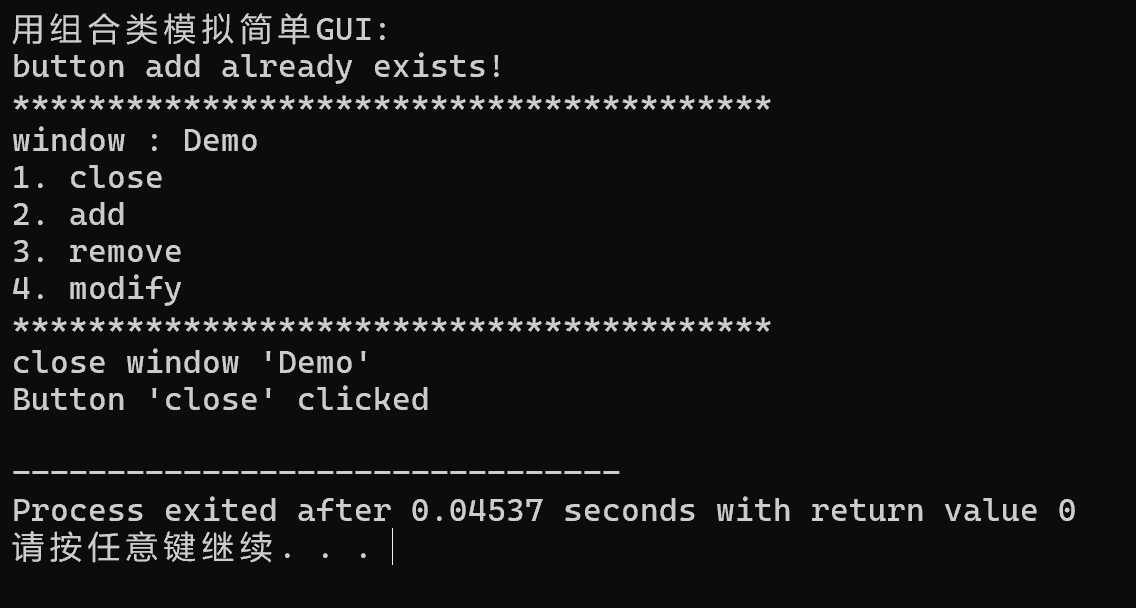
3.问题1
是组合关系。因为Window对象里包含了Button对象,而且,Button对象的生命周期由Window决定,当Window被销毁时,其内部的Button对象也会被销毁。
4.问题2
(1)优点:
①外部可以直接查询窗口是否包含某个按钮,使得查询变得很方便、直观
②可以增加接口的灵活性
风险:
①破坏封装性
②在进行进行复杂的逻辑判断时,接口可能会被滥用,从而导致了增加代码耦合度的风险
(2)
①用户是否需要:如果功能是用户直接需要的,设为public;
如果只是起到内部辅助的作用,则设为private;
②是否为内部实现细节:当成员函数涉及对象内部的管理或者数据验证等实现细节的操作时应设为private
③是否易破坏对象状态:当成员函数可能破坏对象完整性时应设为private
综上所述,成员函数应该尽量减少公开接口,只暴露必要的功能。
5.问题3
接口1返回的是常量引用,避免了字符串拷贝;而接口2返回的是字符串副本,涉及到了内存分配和拷贝,所以接口1性能更好,适合频繁调用的场景。
接口1返回的是内部数据的引用,接口2返回的是副本,完全隔离了内部数据。所以接口2安全性更高。
6.问题4
可以正常运行;两种写法的差别在于push_back(Button(xxx))先在外部构造一个Button临时对象,然后将临时对象移动或拷贝到vector中;而emplace_back(xxx)是直接在vector的内存空间中构造Button对象。
二.实验任务2
1.源代码

1 #include <iostream> 2 #include <vector> 3 4 void test1(); 5 void test2(); 6 void output1(const std::vector<int> &v); 7 void output2(const std::vector<int> &v); 8 void output3(const std::vector<std::vector<int>>& v); 9 10 int main() { 11 std::cout << "深复制验证1: 标准库vector<int>\n"; 12 test1(); 13 14 std::cout << "\n深复制验证2: 标准库vector<int>嵌套使用\n"; 15 test2(); 16 } 17 18 void test1() { 19 std::vector<int> v1(5, 42); 20 const std::vector<int> v2(v1); 21 22 std::cout << "**********拷贝构造后**********\n"; 23 std::cout << "v1: "; output1(v1); 24 std::cout << "v2: "; output1(v2); 25 26 v1.at(0) = -1; 27 28 std::cout << "**********修改v1[0]后**********\n"; 29 std::cout << "v1: "; output1(v1); 30 std::cout << "v2: "; output1(v2); 31 } 32 33 void test2() { 34 std::vector<std::vector<int>> v1{{1, 2, 3}, {4, 5, 6, 7}}; 35 const std::vector<std::vector<int>> v2(v1); 36 37 std::cout << "**********拷贝构造后**********\n"; 38 std::cout << "v1: "; output3(v1); 39 std::cout << "v2: "; output3(v2); 40 41 v1.at(0).push_back(-1); 42 43 std::cout << "**********修改v1[0]后**********\n"; 44 std::cout << "v1: \n"; output3(v1); 45 std::cout << "v2: \n"; output3(v2); 46 } 47 48 // 使用xx.at()+循环输出vector<int>数据项 49 void output1(const std::vector<int> &v) { 50 if(v.size() == 0) { 51 std::cout << '\n'; 52 return; 53 } 54 55 std::cout << v.at(0); 56 for(auto i = 1; i < v.size(); ++i) 57 std::cout << ", " << v.at(i); 58 std::cout << '\n'; 59 } 60 61 // 使用迭代器+循环输出vector<int>数据项 62 void output2(const std::vector<int> &v) { 63 if(v.size() == 0) { 64 std::cout << '\n'; 65 return; 66 } 67 68 auto it = v.begin(); 69 std::cout << *it; 70 71 for(it = v.begin()+1; it != v.end(); ++it) 72 std::cout << ", " << *it; 73 std::cout << '\n'; 74 } 75 76 // 使用auto for分行输出vector<vector<int>>数据项 77 void output3(const std::vector<std::vector<int>>& v) { 78 if(v.size() == 0) { 79 std::cout << '\n'; 80 return; 81 } 82 83 for(auto &i: v) 84 output2(i); 85 }
2.运行结果截图
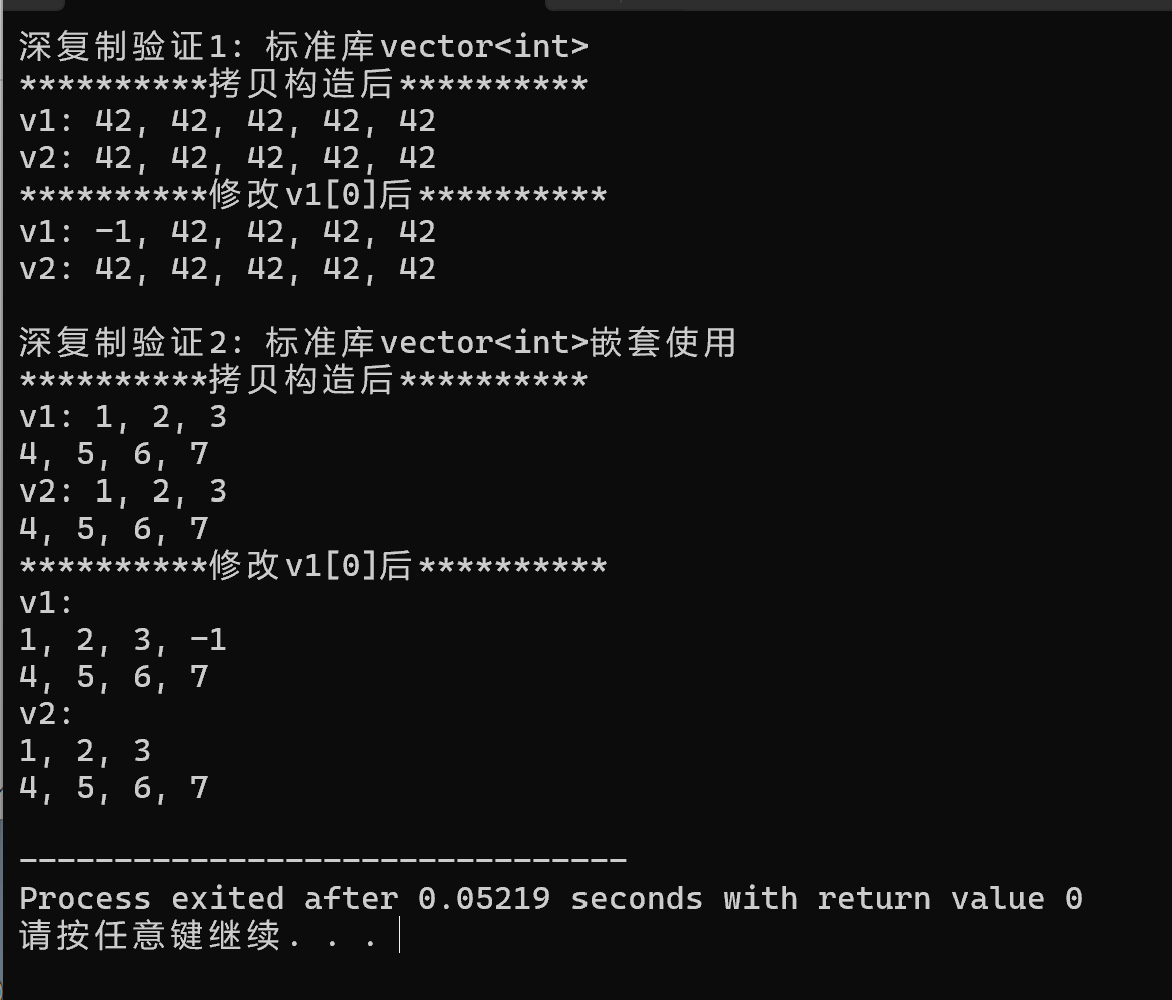
3.问题1
第一行:使用vector的构造函数;第二行:使用拷贝构造函数
v1包含5个值为42的数据项
v2也包含5个值为42的数据项
4.问题2
v1.size() = 2
v2.size() = 2
v1[0].size() = 3
5.问题3
能实现同等效果,区别在于push_back(Button(xxx))在构造过程中是先在函数参数位置构造一个Button临时对象,然后将临时对象拷贝或移动到vector中;emplace_back(xxx)是在vector的内存空间中直接构造Button对象
6.问题4
(1)能输出-1
原因:v1.at(0)返回的是v1第一个内层vector的引用,通过引用r调用push_back(-1)在第一个vector末尾添加了-1。而r.size()-1就是新添加元素的索引,所以r.at(r.size()-1)就是-1。
(2)优势:
①避免了对不必要的对象进行拷贝的操作,节省内存
②性能得到提升
③不会产生临时对象
限制:
①不能通过const引用修改对象内容
②需要确保被引用对象的生命周期长于引用本身
7.问题5
(1)深复制。
(2) v是vector<int> 时,返回值类型是int&
当v是const vector<int>时,返回值类型是const int&
at()必须提供带const修饰的重载版本。
三.实验任务3
1.源代码

1 #pragma once 2 3 #include <iostream> 4 5 // 动态int数组对象类 6 class vectorInt{ 7 public: 8 vectorInt(); 9 vectorInt(int n_); 10 vectorInt(int n_, int value); 11 vectorInt(const vectorInt &vi); 12 ~vectorInt(); 13 14 int size() const; 15 int& at(int index); 16 const int& at(int index) const; 17 vectorInt& assign(const vectorInt &vi); 18 19 int* begin(); 20 int* end(); 21 const int* begin() const; 22 const int* end() const; 23 24 private: 25 int n; // 当前数据项个数 26 int *ptr; // 数据区 27 }; 28 29 vectorInt::vectorInt():n{0}, ptr{nullptr} { 30 } 31 32 vectorInt::vectorInt(int n_): n{n_}, ptr{new int[n]} { 33 } 34 35 vectorInt::vectorInt(int n_, int value): n{n_}, ptr{new int[n_]} { 36 for(auto i = 0; i < n; ++i) 37 ptr[i] = value; 38 } 39 40 vectorInt::vectorInt(const vectorInt &vi): n{vi.n}, ptr{new int[n]} { 41 for(auto i = 0; i < n; ++i) 42 ptr[i] = vi.ptr[i]; 43 } 44 45 vectorInt::~vectorInt() { 46 delete [] ptr; 47 } 48 49 int vectorInt::size() const { 50 return n; 51 } 52 53 const int& vectorInt::at(int index) const { 54 if(index < 0 || index >= n) { 55 std::cerr << "IndexError: index out of range\n"; 56 std::exit(1); 57 } 58 59 return ptr[index]; 60 } 61 62 int& vectorInt::at(int index) { 63 if(index < 0 || index >= n) { 64 std::cerr << "IndexError: index out of range\n"; 65 std::exit(1); 66 } 67 68 return ptr[index]; 69 } 70 71 vectorInt& vectorInt::assign(const vectorInt &vi) { 72 if(this == &vi) 73 return *this; 74 75 int *ptr_tmp; 76 ptr_tmp = new int[vi.n]; 77 for(int i = 0; i < vi.n; ++i) 78 ptr_tmp[i] = vi.ptr[i]; 79 80 delete[] ptr; 81 n = vi.n; 82 ptr = ptr_tmp; 83 return *this; 84 } 85 86 int* vectorInt::begin() { 87 return ptr; 88 } 89 90 int* vectorInt::end() { 91 return ptr+n; 92 } 93 94 const int* vectorInt::begin() const { 95 return ptr; 96 } 97 98 const int* vectorInt::end() const { 99 return ptr+n; 100 }

1 #include "vectorInt.hpp" 2 #include <iostream> 3 4 void test1(); 5 void test2(); 6 void output1(const vectorInt &vi); 7 void output2(const vectorInt &vi); 8 9 int main() { 10 std::cout << "测试1: \n"; 11 test1(); 12 13 std::cout << "\n测试2: \n"; 14 test2(); 15 } 16 17 void test1() { 18 int n; 19 std::cout << "Enter n: "; 20 std::cin >> n; 21 22 vectorInt x1(n); 23 for(auto i = 0; i < n; ++i) 24 x1.at(i) = (i+1)*10; 25 std::cout << "x1: "; output1(x1); 26 27 vectorInt x2(n, 42); 28 vectorInt x3(x2); 29 x2.at(0) = -1; 30 std::cout << "x2: "; output1(x2); 31 std::cout << "x3: "; output1(x3); 32 } 33 34 void test2() { 35 const vectorInt x(5, 42); 36 vectorInt y; 37 38 y.assign(x); 39 40 std::cout << "x: "; output2(x); 41 std::cout << "y: "; output2(y); 42 } 43 44 // 使用xx.at()+循环输出vectorInt对象数据项 45 void output1(const vectorInt &vi) { 46 if(vi.size() == 0) { 47 std::cout << '\n'; 48 return; 49 } 50 51 std::cout << vi.at(0); 52 for(auto i = 1; i < vi.size(); ++i) 53 std::cout << ", " << vi.at(i); 54 std::cout << '\n'; 55 } 56 57 // 使用迭代器+循环输出vectorInt对象数据项 58 void output2(const vectorInt &vi) { 59 if(vi.size() == 0) { 60 std::cout << '\n'; 61 return; 62 } 63 64 auto it = vi.begin(); 65 std::cout << *it; 66 67 for(it = vi.begin()+1; it != vi.end(); ++it) 68 std::cout << ", " << *it; 69 std::cout << '\n'; 70 }
2.运行结果截图
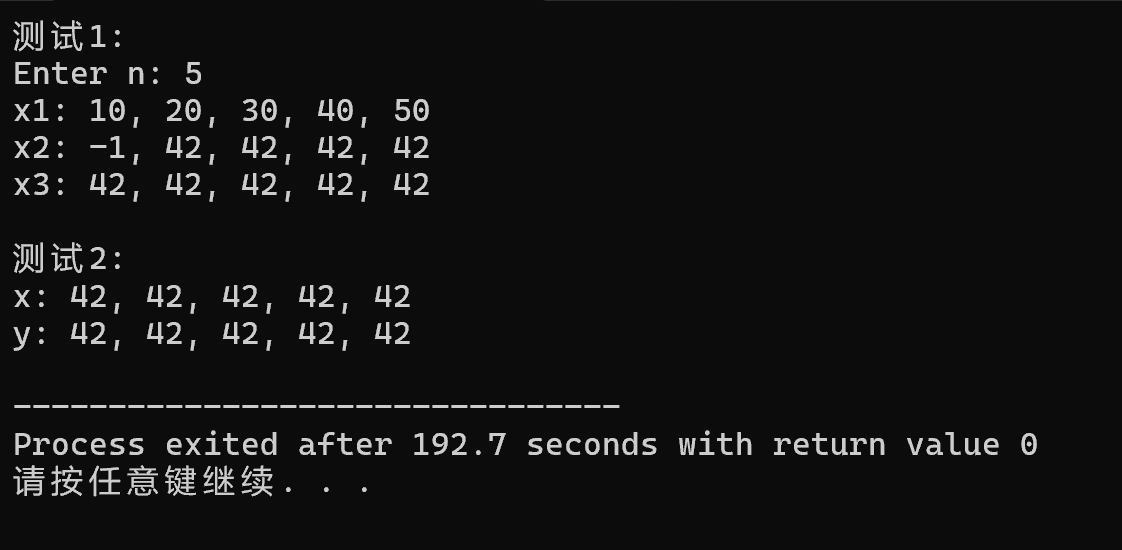
3.问题1
安全隐患和缺陷:
①没有检查 this == &vi,如果自赋值会导致先删除自己的ptr,然后访问已删除的vi.ptr,产生未定义行为;
②如果new int[n]内存不足,对象将处于无效状态
③ptr已被删除但n已更新,会导致对象完整性被破坏
④内存泄漏风险
4.问题2
(1)static_cast<const vectorInt*>(this)的作用是将当前对象指针转换为const类型
转换前:vectorInt*为非const指针
转换后:const vectorInt*为const指针
目的:为了调用const版本的at函数,避免递归调用
(2)const_cast<int&>的作用是移除用转换为非const引用
5.问题3
(1)auto it1 = v1.begin(); // 调用非const版本,返回int*
auto it2 = v2.begin(); // 调用const版本,返回const int*
使用场景:
非const版本:用于需要修改容器内容的场景
const版本:用于只读访问
(2)理解:我认识到了迭代器是访问容器元素的通用接口,对于连续内存容器而言,指针也是迭代器,可以随机访问。
6.问题4
可以
更新代码功能:
std::fill_n(ptr, n, value):将ptr开始的n个元素都设置为value,替代手写的for循环初始化
std::copy_n(v1.ptr, vi.n, ptr):从v1.ptr拷贝vi.n个元素到ptr,替代手写的元素逐个拷贝
std::copy_n(v1.ptr, vi.n, ptr_tmp):从v1.ptr拷贝vi.n个元素到临时缓冲区ptr_tmp
四.实验任务4
1.源代码

1 #pragma once 2 3 #include <iostream> 4 #include <algorithm> 5 #include <cstdlib> 6 7 // 类Matrix声明 8 class Matrix { 9 public: 10 Matrix(int rows_, int cols_, double value = 0); // 构造rows_*cols_矩阵对象, 初值value 11 Matrix(int rows_, double value = 0); // 构造rows_*rows_方阵对象, 初值value 12 Matrix(const Matrix &x); // 深复制 13 ~Matrix(); 14 15 void set(const double *pvalue, int size); // 按行复制pvalue指向的数据,要求size=rows*cols,否则报错退出 16 void clear(); // 矩阵对象数据项置0 17 18 const double& at(int i, int j) const; // 返回矩阵对象索引(i,j)对应的数据项const引用(越界则报错后退出) 19 double& at(int i, int j); // 返回矩阵对象索引(i,j)对应的数据项引用(越界则报错后退出) 20 21 int rows() const; // 返回矩阵对象行数 22 int cols() const; // 返回矩阵对象列数 23 24 void print() const; // 按行打印数据 25 26 private: 27 int n_rows; // 矩阵对象内元素行数 28 int n_cols; // 矩阵对象内元素列数 29 double *ptr; // 数据区 30 };

1 #include "matrix.hpp" 2 #include <iostream> 3 #include <cstdlib> 4 #include <cstring> 5 6 Matrix::Matrix(int rows_, int cols_, double value) 7 : n_rows(rows_), n_cols(cols_), ptr(new double[rows_ * cols_]) { 8 if (rows_ <= 0 || cols_ <= 0) { 9 std::cerr << "Error: Invalid matrix dimensions\n"; 10 std::exit(1); 11 } 12 for (int i = 0; i < rows_ * cols_; ++i) { 13 ptr[i] = value; 14 } 15 } 16 17 Matrix::Matrix(int rows_, double value) 18 : n_rows(rows_), n_cols(rows_), ptr(new double[rows_ * rows_]) { 19 if (rows_ <= 0) { 20 std::cerr << "Error: Invalid matrix dimensions\n"; 21 std::exit(1); 22 } 23 24 for (int i = 0; i < rows_ * rows_; ++i) { 25 ptr[i] = value; 26 } 27 } 28 29 30 Matrix::Matrix(const Matrix &x) 31 : n_rows(x.n_rows), n_cols(x.n_cols), ptr(new double[x.n_rows * x.n_cols]) { 32 33 std::memcpy(ptr, x.ptr, n_rows * n_cols * sizeof(double)); 34 } 35 36 Matrix::~Matrix() { 37 delete[] ptr; 38 } 39 40 41 void Matrix::set(const double *pvalue, int size) { 42 if (size != n_rows * n_cols) { 43 std::cerr << "Error: Size mismatch in set()\n"; 44 std::exit(1); 45 } 46 47 std::memcpy(ptr, pvalue, size * sizeof(double)); 48 } 49 50 51 void Matrix::clear() { 52 for (int i = 0; i < n_rows * n_cols; ++i) { 53 ptr[i] = 0.0; 54 } 55 } 56 57 const double& Matrix::at(int i, int j) const { 58 if (i < 0 || i >= n_rows || j < 0 || j >= n_cols) { 59 std::cerr << "Error: Index out of range in at()\n"; 60 std::exit(1); 61 } 62 return ptr[i * n_cols + j]; 63 } 64 65 double& Matrix::at(int i, int j) { 66 if (i < 0 || i >= n_rows || j < 0 || j >= n_cols) { 67 std::cerr << "Error: Index out of range in at()\n"; 68 std::exit(1); 69 } 70 return ptr[i * n_cols + j]; 71 } 72 73 int Matrix::rows() const { 74 return n_rows; 75 } 76 77 int Matrix::cols() const { 78 return n_cols; 79 } 80 81 void Matrix::print() const { 82 for (int i = 0; i < n_rows; ++i) { 83 std::cout << at(i, 0); 84 for (int j = 1; j < n_cols; ++j) { 85 std::cout << ", " << at(i, j); 86 } 87 std::cout << '\n'; 88 } 89 }

1 #include <iostream> 2 #include <cstdlib> 3 #include "matrix.hpp" 4 5 void test1(); 6 void test2(); 7 void output(const Matrix &m, int row_index); 8 9 int main() { 10 std::cout << "测试1: \n"; 11 test1(); 12 13 std::cout << "\n测试2: \n"; 14 test2(); 15 } 16 17 void test1() { 18 double x[1000] = {1, 2, 3, 4, 5, 6, 7, 8, 9, 10}; 19 20 int n, m; 21 std::cout << "Enter n and m: "; 22 std::cin >> n >> m; 23 24 Matrix m1(n, m); // 创建矩阵对象m1, 大小n×m 25 m1.set(x, n*m); // 用一维数组x的值按行为矩阵m1赋值 26 27 Matrix m2(m, n); // 创建矩阵对象m2, 大小m×n 28 m2.set(x, m*n); // 用一维数组x的值按行为矩阵m1赋值 29 30 Matrix m3(n); // 创建一个n×n方阵对象 31 m3.set(x, n*n); // 用一维数组x的值按行为矩阵m3赋值 32 33 std::cout << "矩阵对象m1: \n"; m1.print(); 34 std::cout << "矩阵对象m2: \n"; m2.print(); 35 std::cout << "矩阵对象m3: \n"; m3.print(); 36 } 37 38 void test2() { 39 Matrix m1(2, 3, -1); 40 const Matrix m2(m1); 41 42 std::cout << "矩阵对象m1: \n"; m1.print(); 43 std::cout << "矩阵对象m2: \n"; m2.print(); 44 45 m1.clear(); 46 m1.at(0, 0) = 1; 47 48 std::cout << "m1更新后: \n"; 49 std::cout << "矩阵对象m1第0行 "; output(m1, 0); 50 std::cout << "矩阵对象m2第0行: "; output(m2, 0); 51 } 52 53 // 输出矩阵对象row_index行所有元素 54 void output(const Matrix &m, int row_index) { 55 if(row_index < 0 || row_index >= m.rows()) { 56 std::cerr << "IndexError: row index out of range\n"; 57 exit(1); 58 } 59 60 std::cout << m.at(row_index, 0); 61 for(int j = 1; j < m.cols(); ++j) 62 std::cout << ", " << m.at(row_index, j); 63 std::cout << '\n'; 64 }
2.运行结果截图
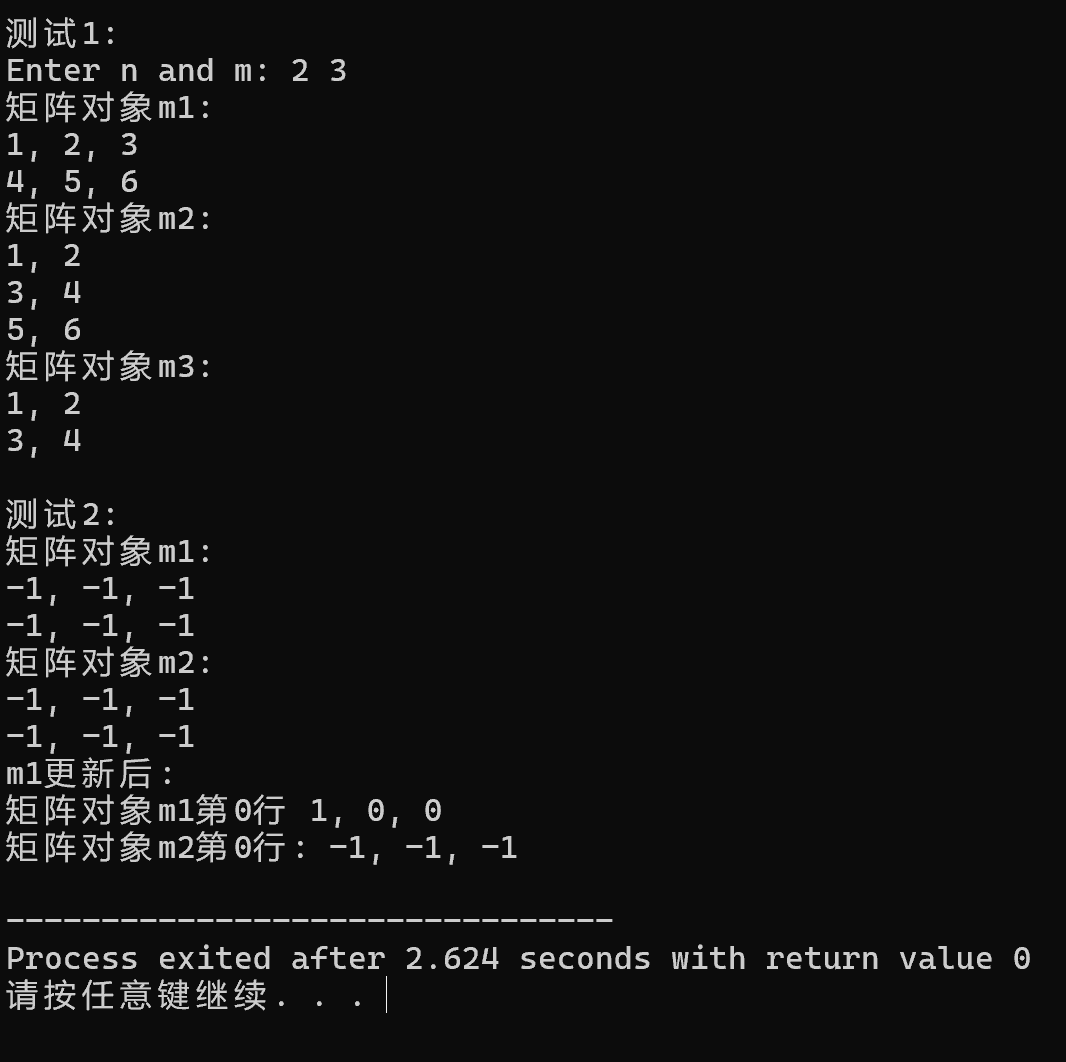
3.拓展思考
谈谈我对"零成本抽象"的体现的理解:
刚开始我觉得用原始指针很酷,像高手一样直接操作内存。但经常会忘记delete导致内存泄漏,或者在复制时出问题,但后来用了std::vector,会发现写起来更简单且不容易出现bug。所以零成本抽象体现在,其能在不牺牲性能的前提下提供更高安全性,从而提高代码效率。
五.实验任务5
1.源代码

1 #pragma once 2 3 #include <iostream> 4 #include <string> 5 6 // 联系人类 7 class Contact { 8 public: 9 Contact(const std::string &name_, const std::string &phone_); 10 11 const std::string &get_name() const; 12 const std::string &get_phone() const; 13 void display() const; 14 15 private: 16 std::string name; // 必填项 17 std::string phone; // 必填项 18 }; 19 20 Contact::Contact(const std::string &name_, const std::string &phone_):name{name_}, phone{phone_} { 21 } 22 23 const std::string& Contact::get_name() const { 24 return name; 25 } 26 27 const std::string& Contact::get_phone() const { 28 return phone; 29 } 30 31 void Contact::display() const { 32 std::cout << name << ", " << phone; 33 }

1 # pragma once 2 3 #include <iostream> 4 #include <string> 5 #include <vector> 6 #include <algorithm> 7 #include "contact.hpp" 8 9 // 通讯录类 10 class ContactBook { 11 public: 12 void add(const std::string &name, const std::string &phone); // 添加联系人 13 void remove(const std::string &name); // 移除联系人 14 void find(const std::string &name) const; // 查找联系人 15 void display() const; // 显示所有联系人 16 size_t size() const; 17 18 private: 19 int index(const std::string &name) const; // 返回联系人在contacts内索引,如不存在,返回-1 20 void sort(); // 按姓名字典序升序排序通讯录 21 22 private: 23 std::vector<Contact> contacts; 24 }; 25 26 void ContactBook::add(const std::string &name, const std::string &phone) { 27 if(index(name) == -1) { 28 contacts.push_back(Contact(name, phone)); 29 std::cout << name << " add successfully.\n"; 30 sort(); 31 return; 32 } 33 34 std::cout << name << " already exists. fail to add!\n"; 35 } 36 37 void ContactBook::remove(const std::string &name) { 38 int i = index(name); 39 40 if(i == -1) { 41 std::cout << name << " not found, fail to remove!\n"; 42 return; 43 } 44 45 contacts.erase(contacts.begin()+i); 46 std::cout << name << " remove successfully.\n"; 47 } 48 49 void ContactBook::find(const std::string &name) const { 50 int i = index(name); 51 52 if(i == -1) { 53 std::cout << name << " not found!\n"; 54 return; 55 } 56 57 contacts[i].display(); 58 std::cout << '\n'; 59 } 60 61 void ContactBook::display() const { 62 for(auto &c: contacts) { 63 c.display(); 64 std::cout << '\n'; 65 } 66 } 67 68 size_t ContactBook::size() const { 69 return contacts.size(); 70 } 71 72 // 待补足1: int index(const std::string &name) const;实现 73 // 返回联系人在contacts内索引;如不存在,返回-1 74 int ContactBook::index(const std::string &name) const { 75 for (size_t i = 0; i < contacts.size(); ++i) { 76 if (contacts[i].get_name() == name) { 77 return static_cast<int>(i); 78 } 79 } 80 return -1; 81 } 82 83 // 待补足2: void ContactBook::sort();实现 84 // 按姓名字典序升序排序通讯录 85 void ContactBook::sort() { 86 87 std::sort(contacts.begin(), contacts.end(), 88 [](const Contact &a, const Contact &b) { 89 return a.get_name() < b.get_name(); 90 }); 91 }

1 #include "contactBook.hpp" 2 3 void test() { 4 ContactBook contactbook; 5 6 std::cout << "1. add contacts\n"; 7 contactbook.add("Bob", "18199357253"); 8 contactbook.add("Alice", "17300886371"); 9 contactbook.add("Linda", "18184538072"); 10 contactbook.add("Alice", "17300886371"); 11 12 std::cout << "\n2. display contacts\n"; 13 std::cout << "There are " << contactbook.size() << " contacts.\n"; 14 contactbook.display(); 15 16 std::cout << "\n3. find contacts\n"; 17 contactbook.find("Bob"); 18 contactbook.find("David"); 19 20 std::cout << "\n4. remove contact\n"; 21 contactbook.remove("Bob"); 22 contactbook.remove("David"); 23 } 24 25 int main() { 26 test(); 27 }
2.运行结果截图
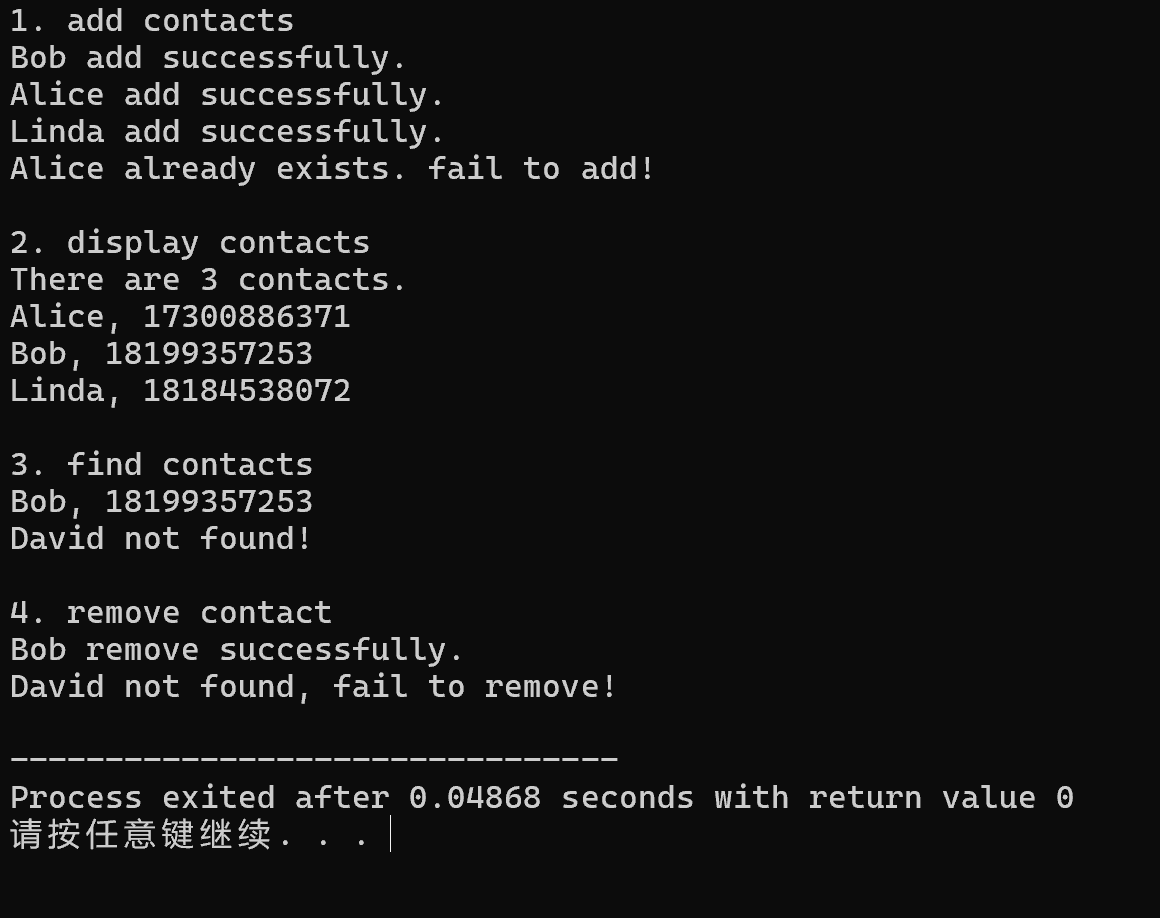
3.拓展思考
仅拓展思考了前两个的改进思路
(1). 修改联系人功能扩展思路
保持兼容性:在现有联系人功能基础上,增加新的修改方法,而不是改变原来的获取信息方式。这样之前写好的代码都能继续正常工作。即在现有Contact类基础上,添加update方法而非直接修改内部状态,这样不会破坏现有的get_name和get_phone接口。
设计考虑:可以让每个联系人信息创建后就不能直接改动,需要修改时就创建一个新的联系人信息替换旧的。
(2).数据有效性校验实现路径
①可以通过分层校验:
首先,在用户输入时即时验证;其次在ContactBook中的添加、修改操作前验证;
然后在数据存储前进行最终验证
②校验内容:
电话号码格式(长度、字符、国际区号)
姓名有效性(特殊字符、长度限制)
邮箱格式(如果未来扩展)
六.总结
核心收获提炼
1. 面向对象设计思维的深化
通过五个递进的实验任务,我深刻体会到面向对象编程不仅仅是语法层面的类与对象,更是一种思维方式。从简单的Button-Window组合到复杂的Matrix资源管理,每个实验都在训练我将现实问题抽象为对象交互的能力。
2. 资源管理的重要性和实践
实验3和实验4让我真正理解了RAII(资源获取即初始化)原则的价值。从手动管理内存的vectorInt到使用std::vector的Matrix改进版,我亲身体验了"零成本抽象"的现实意义——既获得安全性又不损失性能。
3. 接口设计的艺术
实验1中关于public/private成员的讨论让我意识到良好的接口设计是软件可维护性的关键。适度的封装和信息隐藏能够有效降低模块间的耦合度。
待解疑问与进一步探索方向
1在现代C++中,什么时候应该优先使用智能指针而非原始指针?各种智能指针的使用场景如何界定?
2.在团队协作中,如何确保所有成员对面向对象设计原则有一致的理解和实践?





 浙公网安备 33010602011771号
浙公网安备 33010602011771号